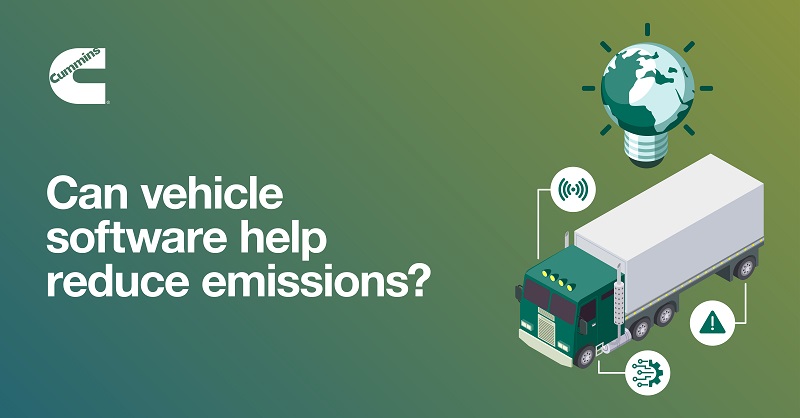Role of vehicle software in the journey to reducing emissions
By Cummins Components Business Unit

Vehicle software has emerged as a key tool in the transportation industry’s journey towards cleaner operations. As the global focus sharpens on reducing environmental impacts, advanced software systems are playing a bigger role in vehicle management. Whether it is optimizing fuel usage, minimizing exhaust gas emissions or optimizing electric and hybrid vehicles, software is at the forefront guiding us towards a more sustainable future.
This article explores the integral role vehicle software plays in these advancements, shedding light on how they can assist OEMs in achieving their goals for reduced emissions, enhanced efficiency and optimal performance.

Vehicle software enhances fuel efficiency
Vehicle software can help in optimizing fuel usage which is a key priority for fleets. Vehicle software can significantly improve combustion and reduce emissions by fine-tuning the fuel injection process, which reduces the amount of fuel used. An example of this software is Cummins Inc.'s ADEPT™ (Advanced Dynamic Efficient Powertrain Technology) . The engine control modules (ECMs) also play a pivotal role in ensuring the combustion process is as efficient as possible by employing algorithms to regulate the injection of fuel.
In addition to helping reduce emissions, these vehicle software programs help improve the vehicle's overall efficiency. For instance, predictive analytics software can anticipate road conditions and adjust engine parameters accordingly to optimize fuel consumption. Fleet management software (discussed more in-depth later in the article) is another tool that allows for close monitoring and management of fuel usage across an entire fleet.

Vehicle software helps reduce exhaust gas emissions
Vehicle software can control and optimize exhaust gas recirculation (EGR) systems, a vital component for reducing nitrogen oxide (NOx) emissions. By precisely managing the EGR system, vehicle software can regulate the reintroduction of a portion of the exhaust gases back into the engine's combustion chamber. This process reduces the amount of oxygen in the chamber, leading to lower combustion temperatures and consequently, reduced NOx emissions.
Technologies such as selective catalytic reduction (SCR) further complement this process. Software controls the injection of a urea solution into the exhaust stream, which reacts with NOx gases to produce nitrogen and water. This helps reduce emissions.
Further, modern vehicles are increasingly equipped with onboard diagnostics software that monitors the performance of the emissions control system. This type of software can detect any irregularities in the emission levels and prompt timely alerts for maintenance or repairs.
Computer-controlled variable valve timing (VVT) technology also allows for more flexible control of the engine's operations, enhancing efficiency and reducing emissions.

Vehicle software enables electric and hybrid vehicle technologies
Vehicle software is helping improve performance and increase adoption of electric and hybrid vehicles. These vehicles utilize software to manage various aspects of battery operation. From monitoring battery charge levels to managing temperature, all of which is vital to maintaining optimal battery health and vehicle performance. Additionally, these vehicle software systems help in optimizing energy use. They assist with the even distribution of power between the engine and the battery in hybrid models, as well as help in recapturing energy during the braking process. Onboard and offboard vehicle software also work together to manage charging frequency and route planning on long-haul journeys.
Furthermore, vehicle software advancements have facilitated the emergence of Vehicle-to-Grid (V2G) technology that is improving the integration of electric vehicles into the existing power grid. Coupled with intelligent charging systems that can plan vehicle charging during periods of low electricity demand, this technology can play a role in enhancing grid stability and increasing the utilization of renewable energy sources.
Fleet management software helps minimize emissions
Incorporating fleet management software can improve fuel efficiency and minimize emissions. Fleet management software provides tools that cut down idle time, a significant factor in unnecessary fuel use and higher emissions. With detailed reports on idle times, fleet managers can identify opportunities to reduce idle periods through targeted driver training or adopting new technologies that restrict idle times. Moreover, many of these vehicle software solutions can integrate with the vehicle's existing systems, offering a deeper understanding of fuel consumption patterns and enabling a more grounded strategy in managing the fleet's environmental footprint.
Predictive maintenance software helps cut down maintenance costs
Utilizing predictive maintenance software can extend a vehicle's lifespan. Tools from Cummins' remote prognostics and maintenance solutions and services use data analytics to highlight potential maintenance issues before they develop into larger problems. This proactive approach helps to cut down on maintenance costs and vehicle downtime. Incorporating predictive maintenance software in fleet management processes is a straightforward strategy for steering towards cleaner energy practices.
These tools integrate easily with the existing systems in the vehicles, providing valuable insights into the vehicle’s health and performance trends over time. This kind of data assists fleet managers in making informed decisions, aiming to ensure that vehicles are running efficiently and with reduced fuel consumption and reduced emissions.
The steady adoption of advanced vehicle software in vehicle management allows fleets to achieve better fuel efficiency and reduced emissions. This ultimately helps the transportation industry become more sustainable in pursuit of a cleaner world.
At Cummins, we’re working to integrate the latest technology and software into our engines and power solutions. Contact us today to learn how we can partner on the path to more sustainable operations.
Author Profiles
Related Tags